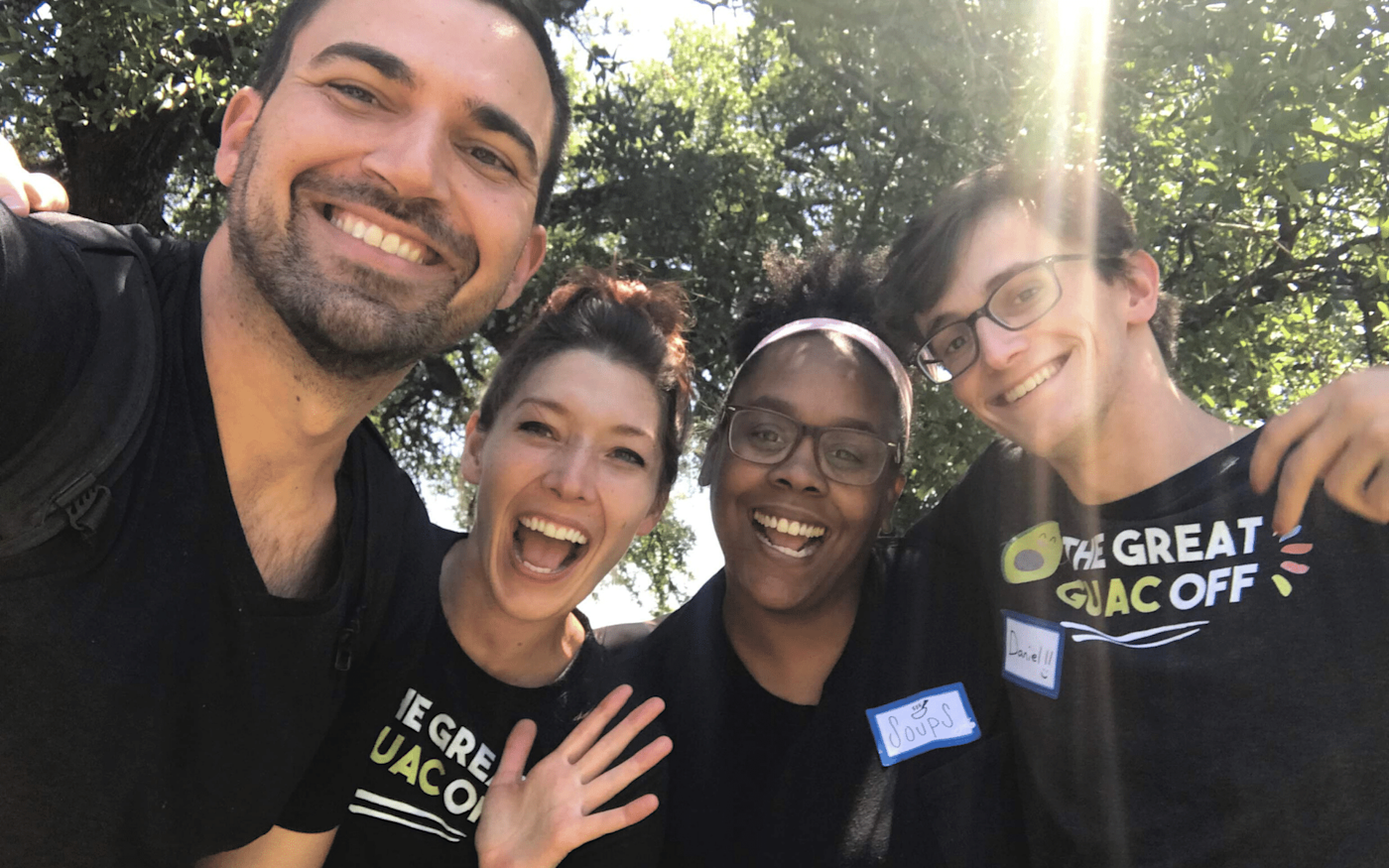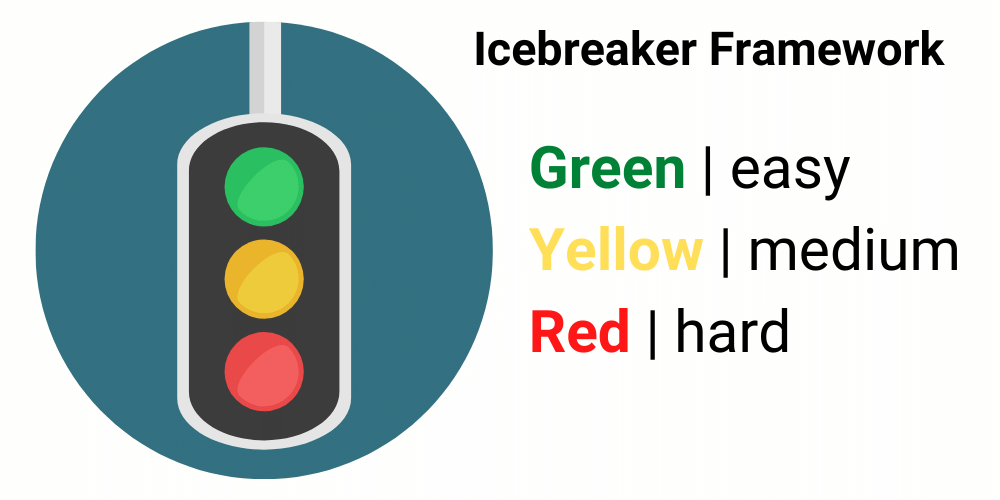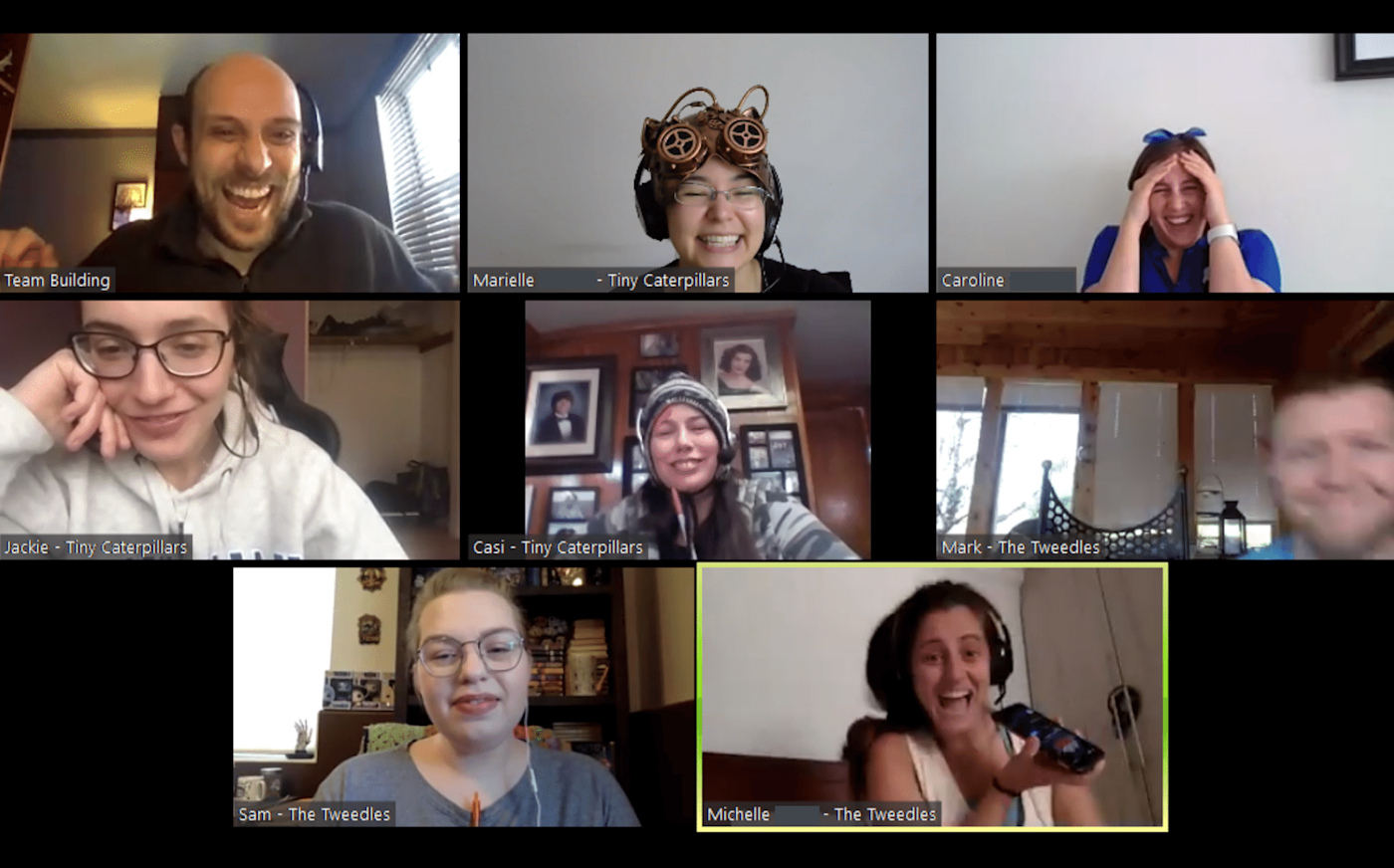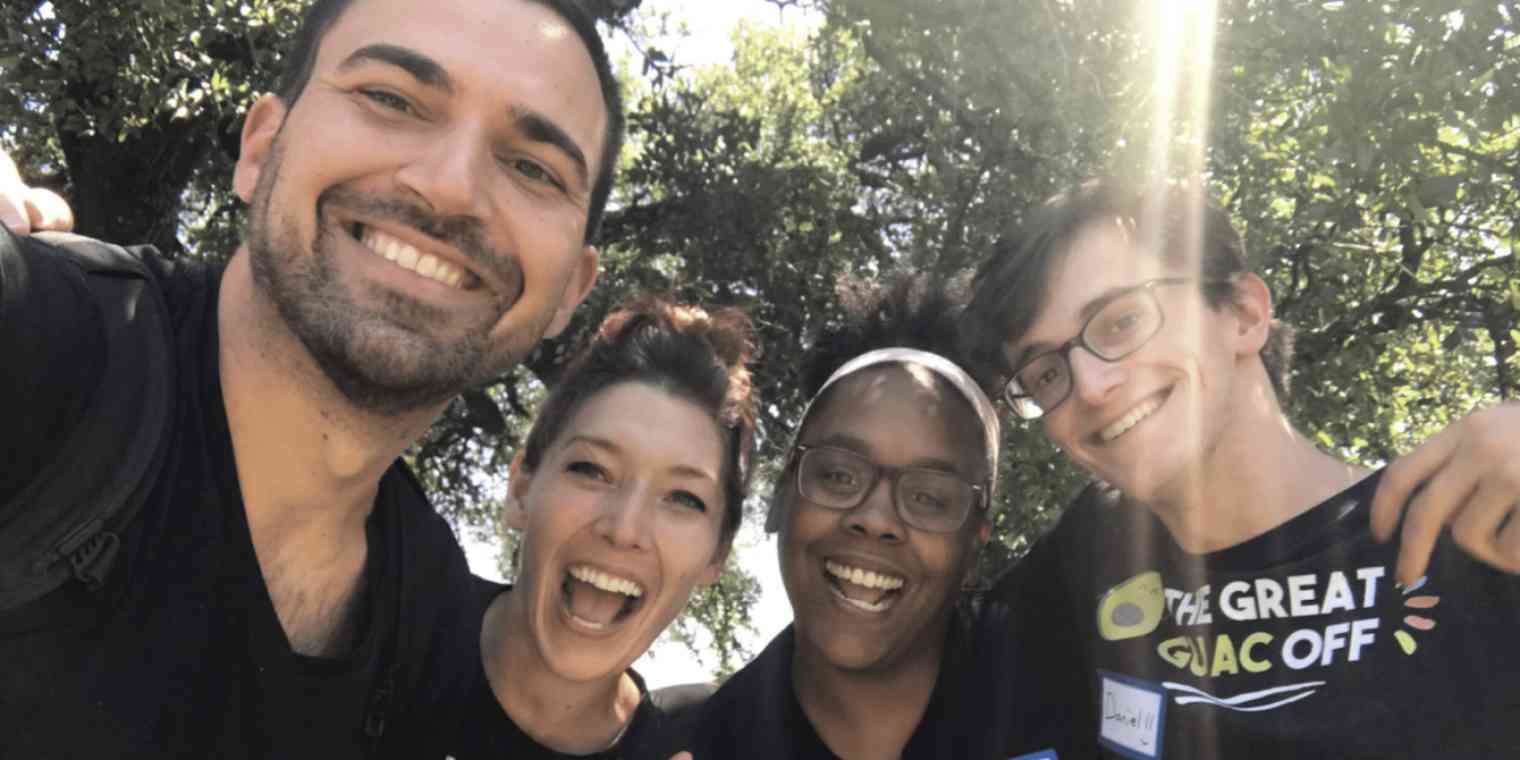Years ago, I joined my first virtual meeting. The host started with the dreaded icebreaker: "your name and what you hope to get from this program."
You could almost hear the groans.
Icebreakers have a ton of potential to elevate your meetings, but bad icebreakers can fall flat and suck the energy out of the virtual room.
My company, TeamBuilding, has run thousands of icebreakers—both internally and for clients like Apple, Amazon, Google, Johnson & Johnson, and Chipotle. So when it comes to icebreakers, we're literally professionals. Here we'll look at how to take your icebreakers from "ugh, not this again" to "that was actually kinda fun." No more awkward silences. No more speaking over each other. No more wondering who is going next. Just super successful virtual icebreakers—every single time.
Why icebreakers work for virtual meetings
At TeamBuilding, we've always been remote. Like Zapier, we don't have an office anywhere, so we've had time to address the common challenges of remote work. One of these challenges? You don't get as much time to just chat. For example, you don't get to say "hi" in the morning when you pass people on your way to your desk or enjoy lunch or an afternoon coffee with a colleague. Even those simple interactions are enough to develop trust.

When you work from home, you need to be intentional about getting that social time in. Icebreakers are one of the easiest and quickest virtual team-building activities to get started with.
The process really only takes five minutes, and that investment will lead to more engaged employees and more productive collaboration. It's very win-win—when you get it right.
The first thing is to start with a solid framework.
The traffic light framework
There are three main icebreaker levels. At TeamBuilding, we call them green, yellow, and red to correspond with traffic lights, but you could use any combination that means easy, medium, and hard.

Green. "Easy" icebreakers are for groups with new members or with low levels of familiarity. At the green level, the answer doesn't reveal much personal info, and anyone should be able to answer quickly. For example, "dogs or cats?" or "how do you take your coffee?"
Yellow. "Medium" icebreakers are for groups that have been together for a while. Yellow questions reveal more personal insights or opinions about relatively simple topics. Most people will be able to answer these prompts quickly. For example, "where is your dream location to work from?" or "have you ever left a one-star review?"
Red. "Difficult" icebreakers are for groups that are already very comfortable with each other. This level requires vulnerability, but that vulnerability leads to strong bonds among coworkers. Example questions: "What is your most popular tweet?" or "What is the last book you read?"
Don't skip ahead to yellow or red if your group isn't ready for it. Instead, use a scaffolding framework where you lay the foundation with some easy green questions, and then as people become more comfortable sharing, you can escalate to a higher tier.
Once you choose the category, you can then select a question that fits your group. Here are a few favorites:
What was your first online screen name?
Which web browser do you use and why?
Where would you haunt for all of eternity?
What book did you read last?
Who is your oldest friend you are still in touch with?
What is your favorite productivity hack?
And maybe my favorite of all time, but very red level: "What is something you've been thinking about lately that no one has asked you about yet?"
Here is an entire list of virtual icebreaker questions for more inspiration.
The two best formats for virtual icebreakers

There are all kinds of icebreaker formats, most of which involve simple prompts. We recommend starting with either a traditional sequential format or a modified version of Never Have I Ever. The sequential format takes about 30 seconds per participant, while Never Have I Ever can work with even very large groups in about one minute flat.
Sequential answers
Sequential answers are the go-to standard for icebreakers: ask a question, and then each participant answers in sequence. The problem is that many people run these as a free-for-all. No one knows who's going next, which results in talking over each other—and anxiety for folks who are less comfortable speaking up.
Instead, start your prompt by saying something like this: "Ok, for today's icebreaker, you'll share your name, your role, and what you ate for breakfast. I'll go first, and then I'll pass to Emily with Lin on deck."
Let's break that down:
The first portion is the prompt itself—nothing too unique about this. I do recommend you ask people to share names because it's super helpful for new folks. Even with office veterans, it may give someone the chance to correct a wrong pronunciation that has taken over.
"I'll go first" lets participants know that you will start, and more importantly, it gives them a moment to think about their answers too.
The final portion, where you name the next two people, is the key to making virtual icebreakers work. In person, you can form a circle to indicate who's next, but on Zoom there is no circle. By naming the next two people in line, you can provide order. After each set goes, you then name the next person up and who's on deck.
This process encourages healthy employee engagement during your call, instead of a healthy amount of fretting.
Pro tip: For an alternative, we sometimes do Icebreaker Chat Roulette, which is when the host asks all participants to drop their names in the chat box. The order the names appear is the order the icebreaker goes in, which is helpful since everyone can see the list and know exactly when their turn is.
Never Have I Ever
The second format, sometimes called "Never Have I Ever" or "Five Strikes," is for larger groups that don't know each other super well.
Here's how it works:
The host prepares a list of five prompts that indicate some specific life experience. For example, "Never have I ever… mixed two types of breakfast cereal."
Each player starts with five fingers up, which works well on video conference calls because there's a clear visual and an easy way for everyone to participate.
If a person has the prompted life experience, they put a finger down.
You can say the winner is the first person to put all fingers down, or whoever has the most fingers remaining; it doesn't really matter. The mechanic that makes Five Strikes work for remote team building is that you can quickly scan and see with each prompt who has or does not have each experience. This process highlights shared experiences, which can help form bonds.
Pro tip: Make sure you choose a diverse range of questions. If your prompts are America-centric, for example, then you may exclude international team members.
Best practices for virtual icebreakers
Before we go, here are a few extra best practices to help you run successful virtual icebreakers.
Follow the "Max 15 Rule." This rule simply states that if you have 15+ people on a conference call, you should either use breakout rooms for small group icebreakers or a large group format like Never Have I Ever. Sitting through dozens of icebreakers really disrupts the positive energy and momentum of a call—and takes forever.
Tag people after they answer. On platforms like Zoom, the host and co-host can edit the names of participants. For icebreakers, an easy way to track who's already shared an answer is to add an "X" or other mark after their name. This tagging helps avoid questions like, "who hasn't gone yet?" or "Rob, you went, right?"
Break the ice often. I recommend including icebreakers at the beginning of every virtual meeting you do. The entire process should take less than five minutes, and that five minutes can make a world of difference with your ongoing team-building efforts. You aren't trying to break the entire ice block in one go—just chip away at it!
Be a little goofy. At every tier of the traffic light framework, there's a decision to make: ask a boring question or ask a fun one. The audience of people that attentively listen to a boring icebreaker is very small. Instead, be willing to ask questions like "which animated character would be your BFF?" or "are you wearing socks, and why?"
Use icebreakers that frame your conversation. You should absolutely try to align your icebreakers with the goal of your meeting. For example, if the goal of the meeting is to introduce more tenured team members with newer folks, you might ask, "how did you join the company?" and everyone could share their origin story. At an annual all-hands meeting, you could prompt participants to share a favorite memory from the last year or something they're looking forward to in the next one.
Icebreakers aren't only for group meetings. They can be a great conversation starters for pair buddy meet-ups or 1:1 calls too.
As you plan your virtual icebreakers, spend a little time thinking about where you, as the leader, fit in the framework, prepare some fun questions, and let your people do the rest. From the very first prompt, you'll start to build trust and see bonds forming, and a few meetings in, you may just be ready to tackle some red-level prompts.
Finally, to really supercharge your efforts, check out these high impact tips for maximizing remote employee engagement by TeamBuilding's CEO.
This was a guest post from Tasia Duske. Tasia is the COO of TeamBuilding{: rel="follow" }, a 100% remote company that runs local and virtual team-building activities that your people will love. Tasia has a master's degree in Psychology from Eastern Washington University and a focus on organizational behavior. Find out more on LinkedIn. Want to see your work on the Zapier blog? Check out our guidelines and get in touch.





